Say hello to the darker, but equally decadent sibling of the ever-favorite gulab jamun – the Kala Jamun. It may also be referred to by many other names in different regions of India. Ask an Indian about their favorite mithai (sweet), more than half the population will give you an answer involving any or both of these sweets. This here, is an easy and lovely Kala Jamun recipe made with paneer (cottage cheese) and khoya (evaporated milk solids). Be it a festival or just any special celebration at home, make it and enjoy with your friends and family.
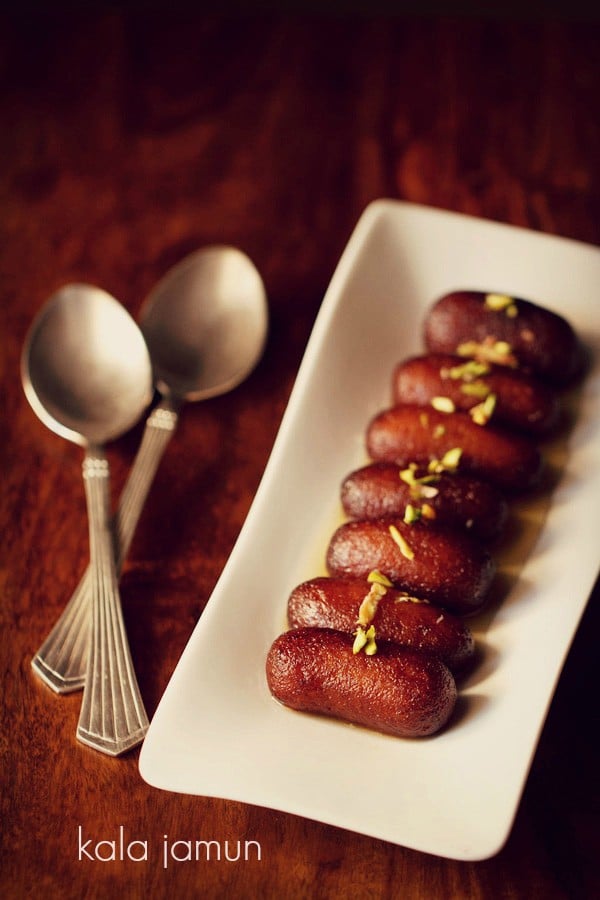
About Kala Jamun
If you are not well-versed with this famous Indian sweet variant, there are high chances that you might confuse it with a fruit of the same name! However, the similarity ends at just the name and the fact that both the mithai and the fruit are blackish/dark purple in color.
Kala Jamun, the sweet is obviously related to the famous gulab jamun and has nothing to do with the tropical fruit, also known as java plum.
Table of Contents
While Kala Jamun recipe does have some similarities with its counterpart, it has other regional names. For instance, kalo jaam or kala jaam. The difference between a Kala Jamun and gulab jamun, primarily, is in the color and texture.
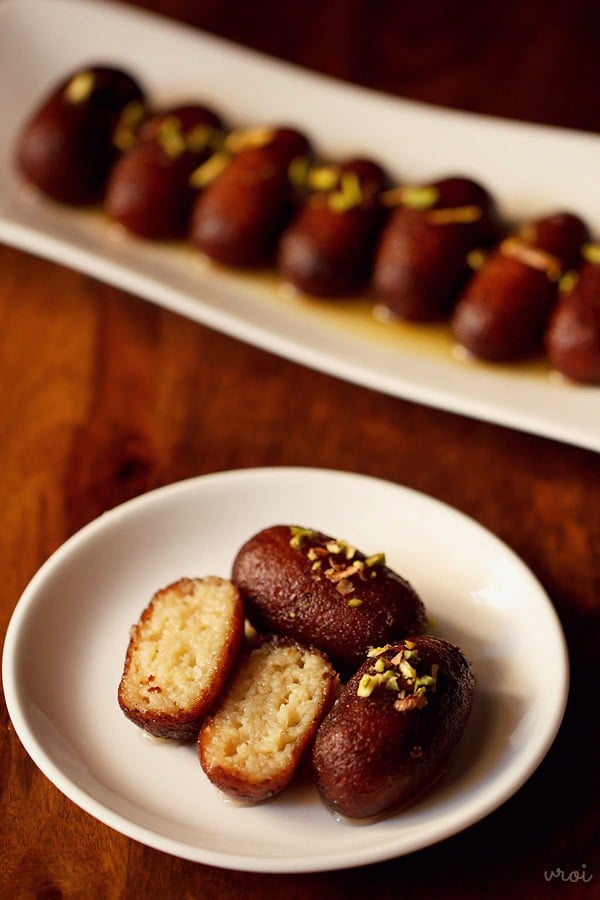
We all know that gulab jamuns are golden colored and Kala Jamun is essentially dark, just some shades away from black or even dark purple. Hence, ‘kala’ which is a Hindi word for black. This characteristic black color is achieved by frying the jamuns on low heat for a longer time. It is as simple as that.
By frying for a longer time, the exterior not only gets a dark hue, but also gets an almost bittersweet flavor and the texture also changes and becomes thicker as compared to that of a gulab jamun.
Another feature that makes these both distinct in their own is the fact that after you make a Kala Jamun recipe, you usually serve it at room temperature. Whereas, gulab jamuns are technically served hot or warm, and sometime at room temperature as well. But whatever it is, the combination of vanilla ice cream with any of these 2 jamuns is just supreme! Try it too.
More on Kala Jamun
Kala Jamun, gulab jamun, Rasgulla, Coconut Ladoo and Jalebi are a few Indian sweets that are an evergreen hit with me and folks too. I mean, we never really get bored of eating these. And I can say the same for any such person, who’s a sweet tooth, especially with an affinity towards the sweets of India.
Traditionally, khoya or mawa is used in a Kala Jamun recipe, and even to make gulab jamuns. Khoya is basically dried evaporated milk solids. These milk solids are obtained by continuously cooking the milk on a low flame, till most of the moisture evaporates.
I have adapted this Kala Jamun recipe too from my recipe of Gulab Jamun. It is quite simple, if you follow the procedure and the methodology religiously. Although, I have shaped these dark colored jamuns in an oblong form, you can even shape them in a round form.
If you follow this Kala Jamun recipe, you might have some dough left, with which you can also make another variation of this sweet, the Dry Jamun. This particular recipe will give you about 35 to 37 Kala Jamuns.
As obvious with this class of sweets, Kala Jamun too is one of the most favorite choices of sweet during festivals like Diwali, Holi, etc. And not just this, it is just perfect for small parties or get togethers at your home as well.
You can prepare the jamuns a day before and keep them soaking in the sugar syrup in the refrigerator. These Kala Jamun stay well for about a week, when refrigerated.
How to make Kala Jamun
Making dough
1. Take 250 grams of khoya in a plate or bowl. The khoya used for the jamuns is the soft khoya known as daap ka khoya or chikna khoya, which mashes and kneads very well.
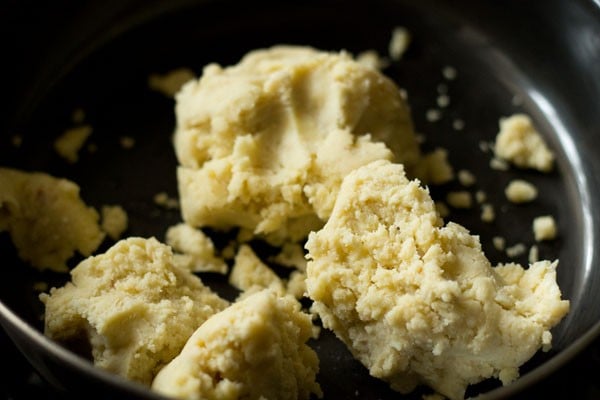
2. Mash the khoya very well with your hands. Keep aside. There should be no lumps or small bits or pieces in the khoya. You can also grate and then mash the khoya. Make sure the mashed khoya does not feel granular to touch.
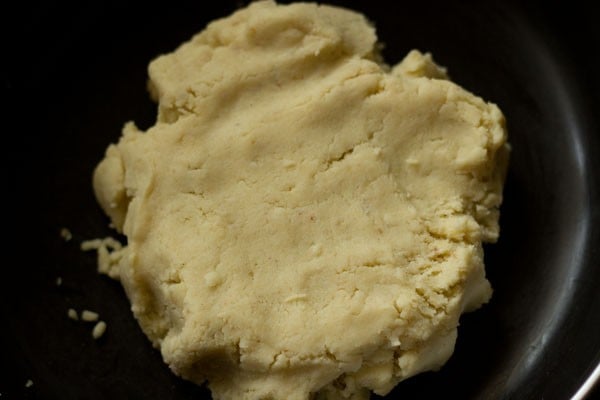
3. Finely grate 100 grams paneer and keep aside. 100 grams paneer yields about ½ cup grated paneer. If you are using freshly made paneer, then make sure it is well strained of the whey.
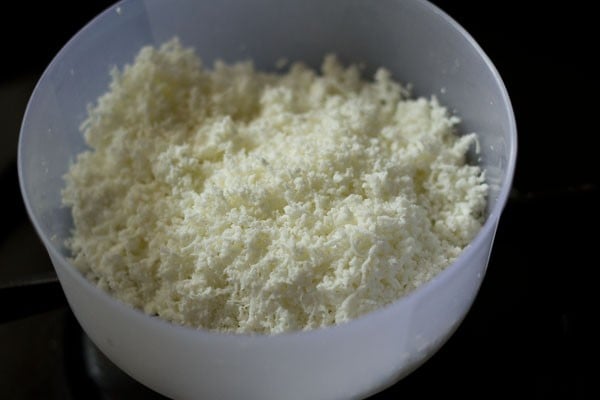
4. Now, add the grated paneer and 3 tablespoons all-purpose flour (maida) to the khoya.
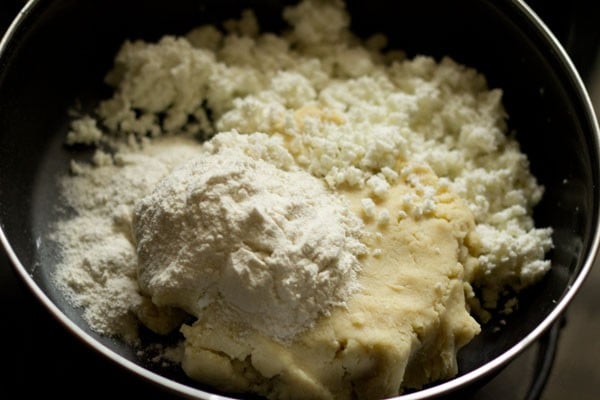
5. Add 1 tablespoon milk.
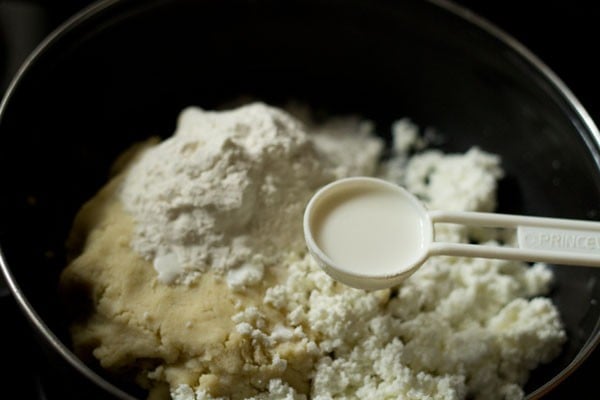
6. Gently mix everything very well.
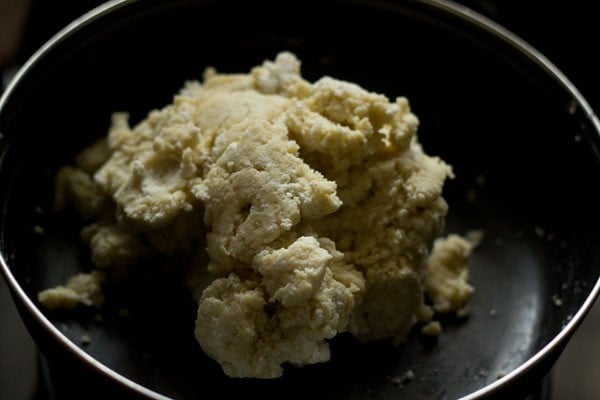
7. Bring this mixture together and form into a dough. Do not knead the dough. Just mix and gather into a ball. If the mixture looks dry and does not cling together, you can add 1 tablespoon more of milk.
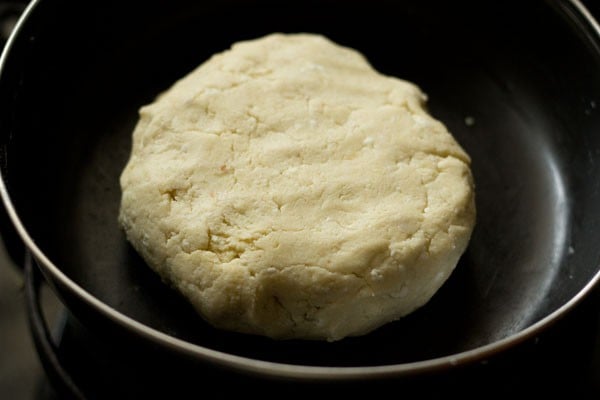
Shaping Kala Jamun
8. Now, pinch small marble sized balls from the dough and roll them in a round shape between your palms. Roll lightly and not heavily.
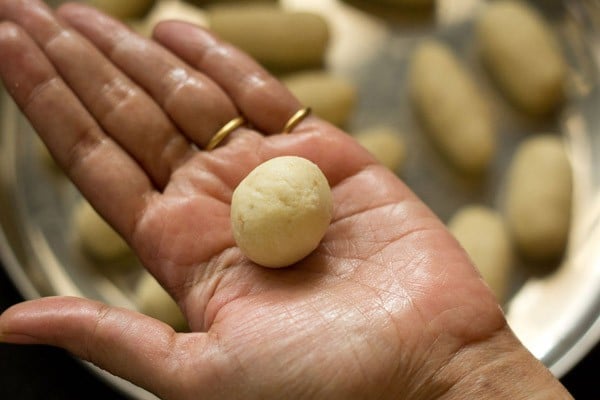
9. Now, roll the ball again between your palms to give an oblong cylindrical shape.
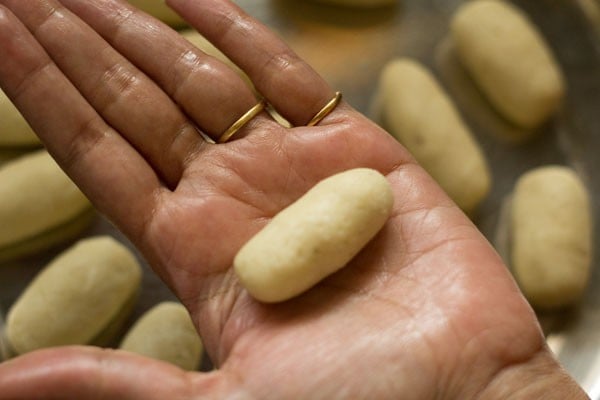
10. Roll all the jamun this way and keep them covered with a cotton kitchen towel. Note that I used only half of the dough to make Kala Jamun and saved the rest for making dry jamun.
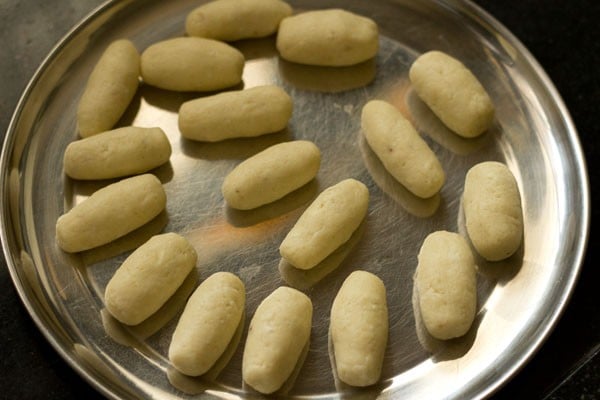
Making sugar syrup
11. Take 2 cups sugar in a pan.
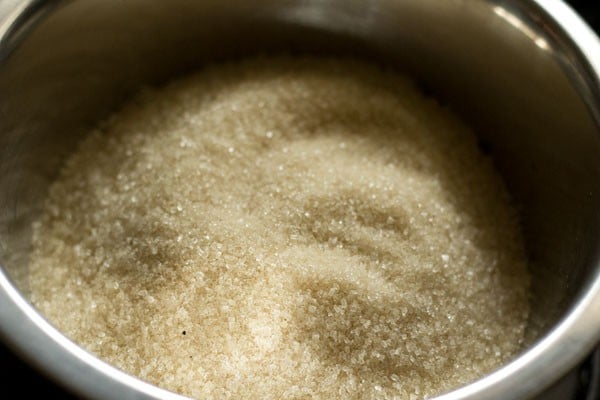
12. Add 1.5 cups water.
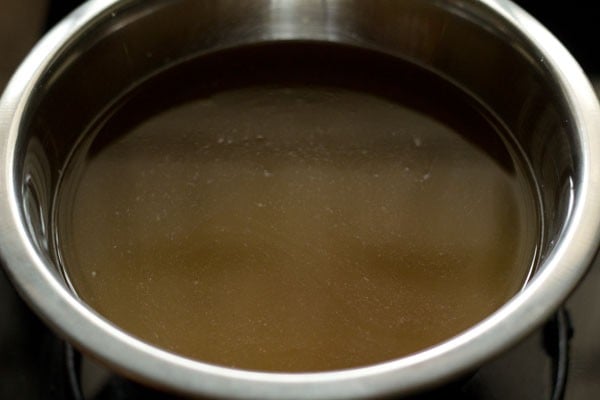
13. Keep this pan on stovetop on low to medium heat and stir so that the sugar begins to dissolve.
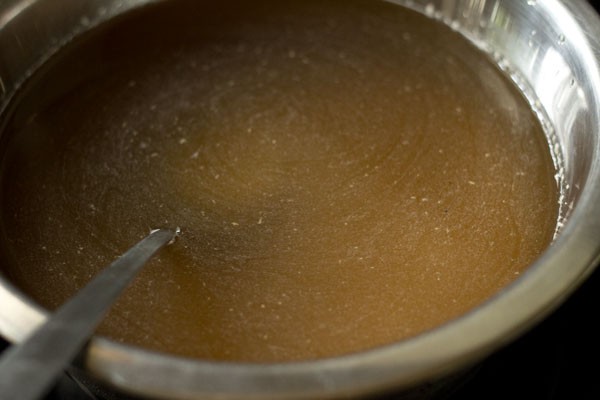
14. When all the sugar is dissolved, add ¼ teaspoon lemon juice, which will prevent the sugar syrup from crystallizing.
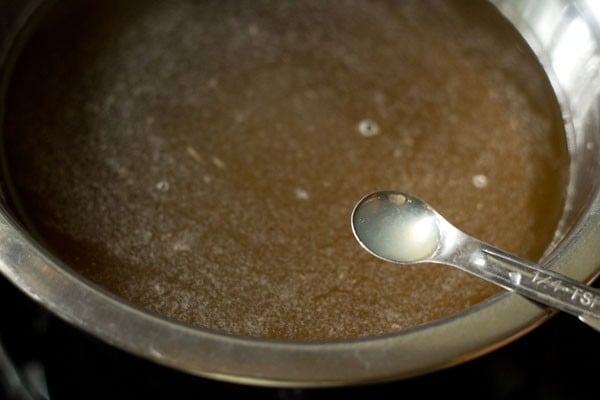
15. Cook the sugar syrup on low to medium heat till it becomes sticky or you get ½ string consistency.
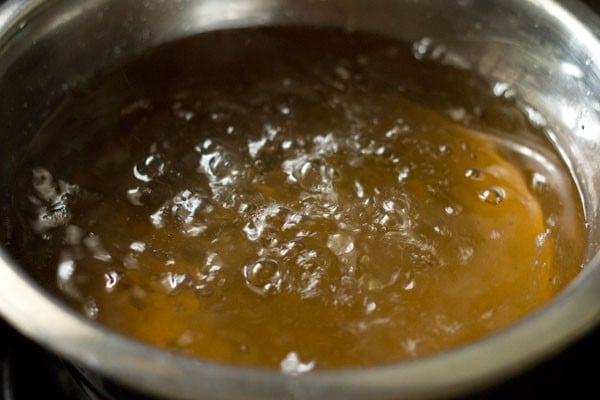
16. Switch off the heat and add ½ teaspoon cardamom powder and 12 to 15 strands of saffron, crushed. Also, add 1 tablespoon rose water.
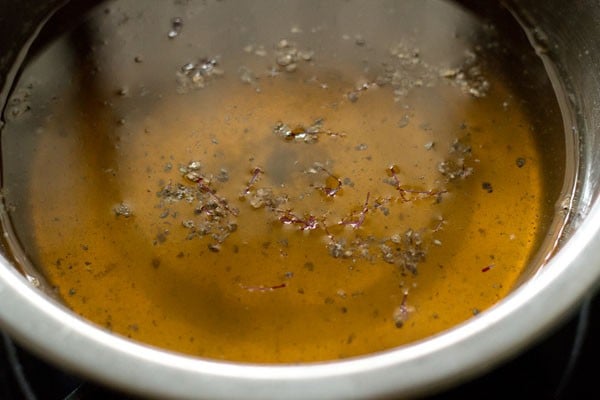
Frying Kala Jamun
17. While the sugar syrup is cooking, begin frying the jamuns. The sugar syrup has to be hot when you add the fried jamuns. Heat oil or ghee in a kadai or deep pan on a low to medium flame for deep frying the jamuns.
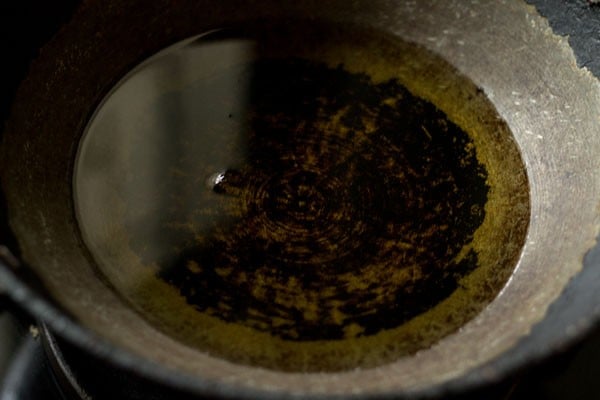
18. For testing, slide a tiny dough ball in the hot oil. The ball should slowly rise up and not pop immediately to the surface. This is the temperature at which we will fry the jamun.
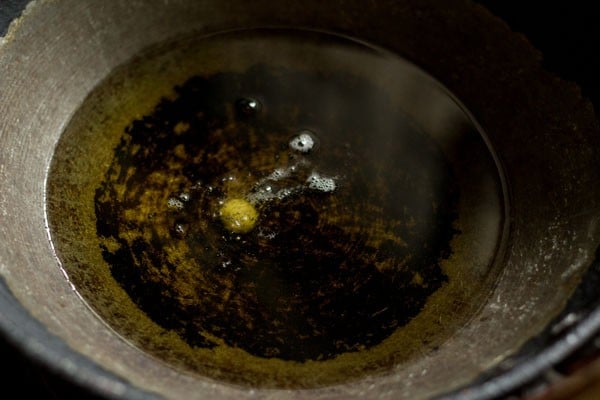
19. Keep the heat to a low and fry the tiny jamun ball.
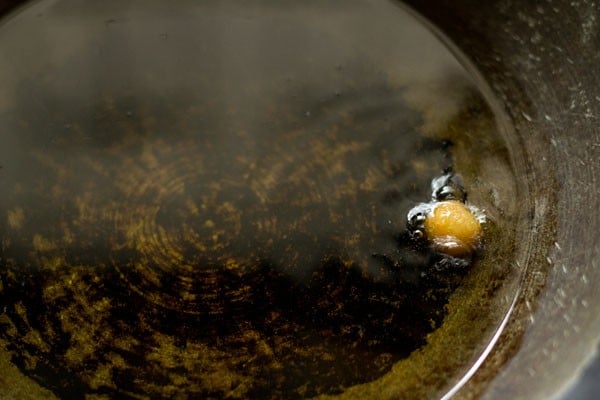
20. Fry your small tester jamun till it becomes golden. If the jamun ball breaks, then add a few teaspoons of flour to the dough and mix well again. I suggest that before you begin shaping the jamuns, you do this test.
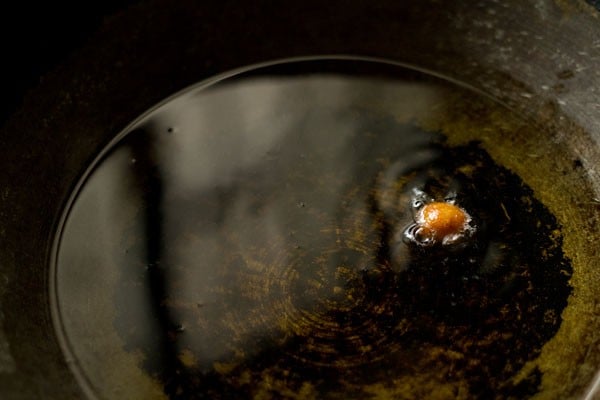
21. Now, working in batches, gently slide the full-sized jamuns into the oil. The heat should be low. Do not crowd the pan.
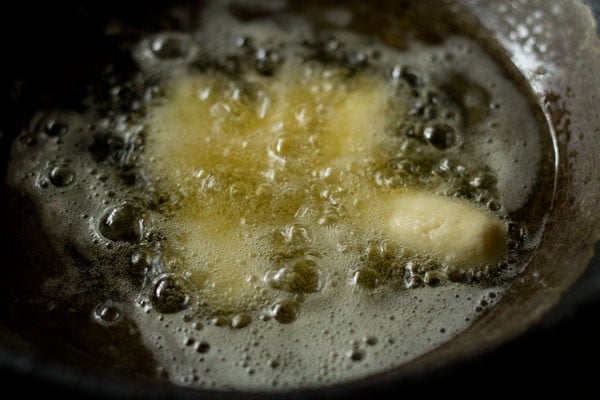
22. When you see light golden spots, gently turn over the jamuns. Here I was handling the camera too, so the jamuns got browned more. The jamuns fry very quickly, so be attentive.
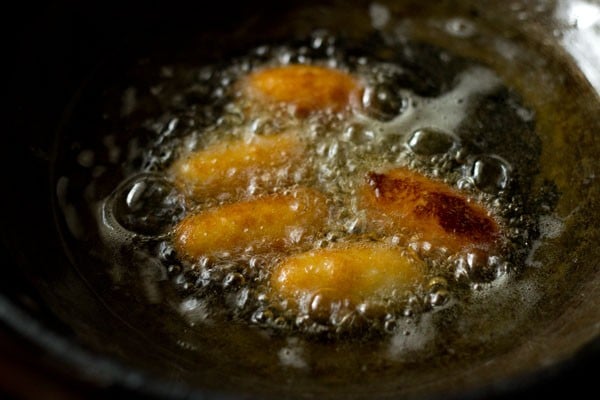
23. Keep on turning them in the oil, like a gentle swirling with the slotted spoon, so that they brown evenly. While frying, the jamuns should feel light like thermocol balls, and not heavy.
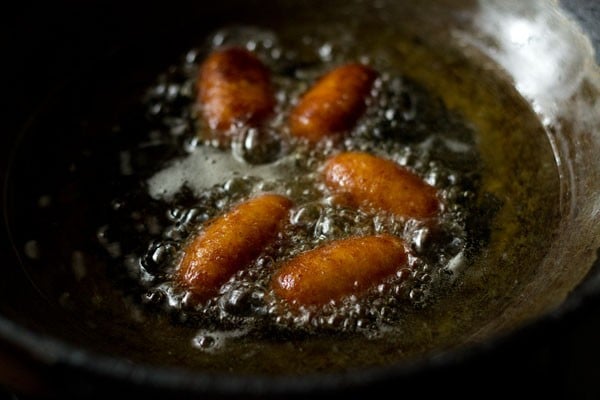
24. Fry till they turn a shade or two darker than the golden color.
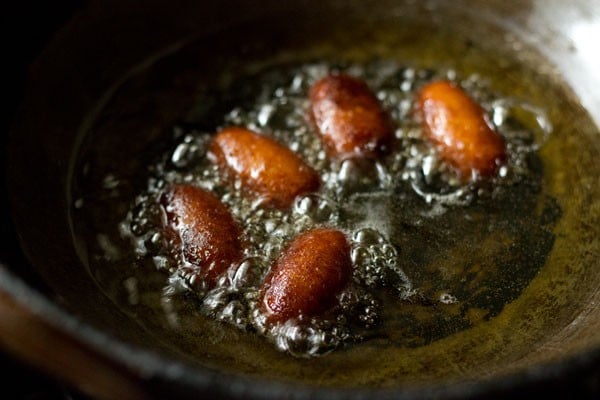
25. Place Kala Jamun on paper towels to remove excess oil.
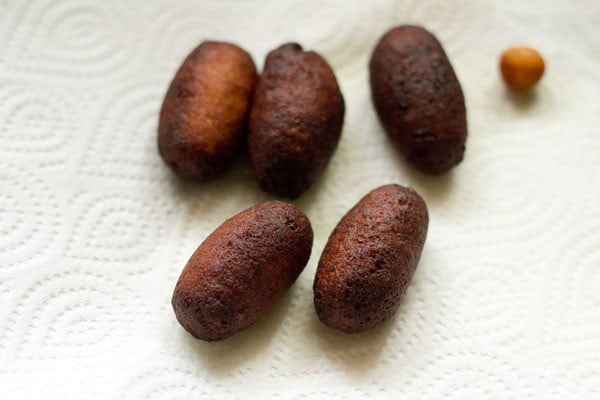
26. Whilst they are still hot from the pan, quickly add Kala Jamun to the sugar syrup. Fry all the jamuns in the same way and then add to the sugar syrup. Note that the sugar syrup has to be hot. To maintain the hot temperature, you can keep the sugar syrup bowl or pan on a hot water bath. Cover and allow the Kala Jamun to soak in the sugar syrup for 3 to 4 hours before serving. Once the sugar syrup cools down, keep the bowl covered in the refrigerator.
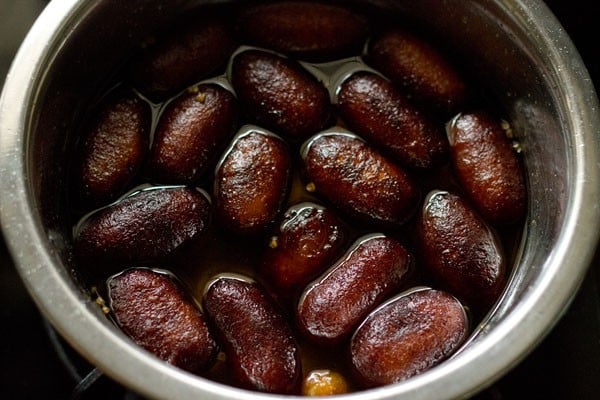
27. Serve Kala Jamun at room temperature or chilled as a dessert. You can garnish with some sliced or chopped pistachios or blanched almonds while serving, or even offer up a scoop of Vanilla Ice Cream to accompany your sweets.
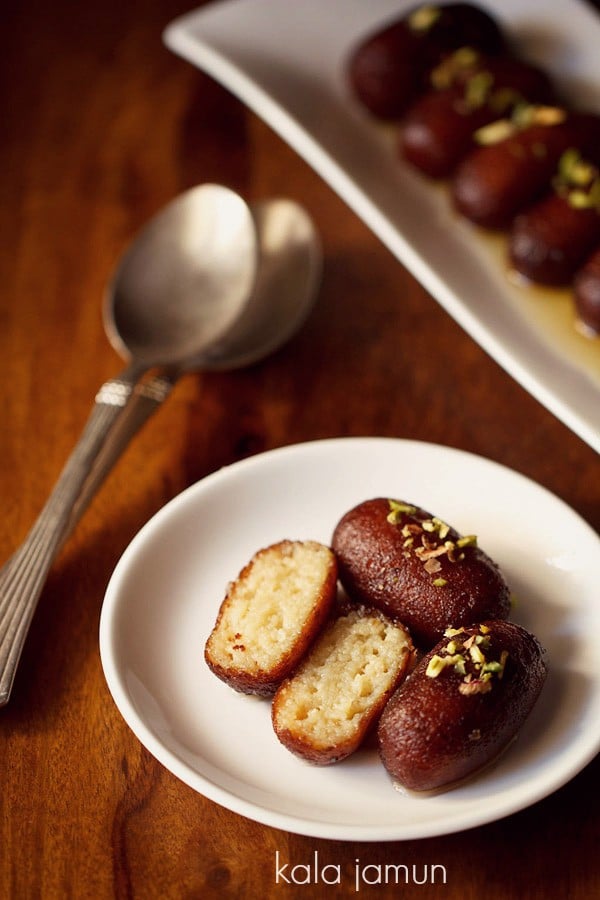
Expert Tips
- You can try making different shaped Kala Jamuns. I gave them an oblong shape, you can make round ones too.
- A special type of soft khoya a.k.a ‘daap ka khoya’ or ‘chikna khoya’ is used to make the Kala Jamun. As it is soft, it mashed and kneads very well.
- You will have to mash the khoya so well that there are no lumps or small bits left in it. It should also not feel granular to touch.
- If you are opting to use freshly made paneer, make sure to strain the whey well out of it.
- While kneading the dough, if the mixture looks dry and doesn’t come together, add 1 tablespoon more milk.
- When you are frying the jamuns, ensure they feel light and not heavy. This lightness is similar to the lightness of thermocol balls.
- Make sure that you are adding the fried jamuns in hot sugar syrup. To maintain the hot temperature of the sugar syrup, you can keep the syrup bowl/pan on a hot water bath.
- Make stuffed jamuns: Flatten the dough and add a small amount of chopped dried fruits, crushed pistachios with kesar, and/or crushed toasted cashews colored with saffron water for a bit of extra texture. Wrap the dough around the filling, shape, then fry as directed.
FAQs
Sounds like one of the two things happened. First, if you mix the dough too much, then the jamuns will become hard. Second, the sugar syrup should not have more than 1-string consistency or it will become too thick. Hence, the jamuns will not be able to absorb the sugar syrup and turn dense.
I’ve heard of this happening with readers who make their own khoya. If you prefer to make khoya (milk solids) instead of buying it, make sure that it has a fine consistency. It should not be granular or have discernible balls in it, or they will cause the dough to be unstable when it goes in the oil.
Absolutely! Just replace it with an equal amount of khoya (and keep the original amount of khoya called for).
Make sure you are frying over medium-low heat for a long time. If you fry it in too hot oil, it will become very dark very quickly, but the center won’t have time to cook properly. Also, be sure to shape your jamuns evenly, so they cook uniformly.
More Diwali Sweets To Try!
Sweets Recipes
Sweets Recipes
Sweets Recipes
Sweets Recipes
Please be sure to rate the recipe in the recipe card or leave a comment below if you have made it. For more vegetarian inspirations, Sign Up for my emails or follow me on Instagram, Youtube, Facebook, Pinterest or Twitter.
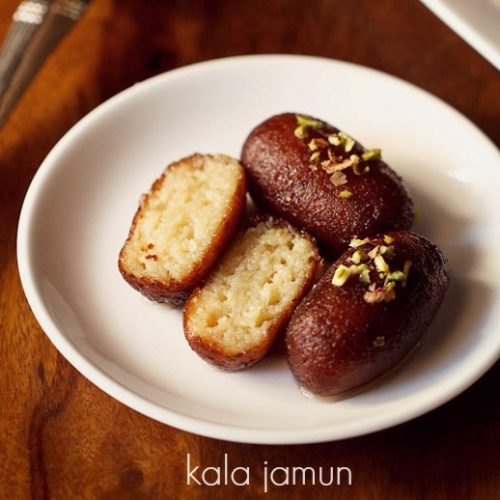
Kala Jamun | Black Gulab Jamun
Ingredients
for kala jamun balls
sugar syrup for kala jamun
- 300 grams sugar or 2 cups sugar
- 1.5 cups water
- ¼ teaspoon lemon juice
- 1 tablespoon rose water
- ½ teaspoon cardamom powder
- 12 to 15 strands of saffron
Instructions
preparation for kala jamun
- Take 250 grams of khoya in a plate or bowl. The khoya used for kala jamun is the soft khoya also known as hariyali khoya or chikna khoya. This is a soft khoya, so it mashes and kneads very well.
- Mash the khoya very well with your hands. Keep aside. There should be no lumps or small bits or pieces in the khoya. You can also grate and then mash the khoya.
- Grate 100 grams paneer and keep aside. 100 grams paneer yields about 1/2 cup grated paneer.
making kala jamun balls
- Now add the grated paneer and 3 tbsp all purpose flour (maida) to the khoya.
- Add 1 tbsp milk. gently mix everything very well.
- Bring together this mixture and form into a dough. Do not knead the dough. Just mix and gather to a dough. If the mixture looks dry and does not cling together to a dough, you can add 1 tbsp more of the milk.
- Now pinch small marble sized balls from the dough and roll them in a round shape between your palms. Roll lightly and not heavily.
- Now roll the ball again between your palms to give a oblong cylindrical shape.
- Roll all the jamun this way and keep them covered with a cotton kitchen towel.
making sugar syrup for kala jamun
- Take 2 cups sugar in a pan and add 1.5 cups water.
- Keep this pan on stove top on a low to medium flame and stir so that the sugar begins to dissolve.
- When all the sugar is dissolved, add 1/4 tsp lemon juice. The lemon juice does not allow the sugar syrup to crystallize.
- Cook the sugar syrup on a low to medium flame till you get 1/2 string consistency or the syrup becomes sticky.
- When the sugar syrup is cooking, you can begin frying the kala jamun. As when you add the kala jamun, the sugar syrup has to be hot. Heat oil for deep frying in a kadai or deep pan on a low to medium flame.
- Switch off the flame and add 1/2 tsp cardamom powder and 12 to 15 strands of saffron, crushed. Also add 1 tbsp rose water.
frying – making black gulab jamun
- For testing, slid a tiny dough ball in the hot oil.
- The ball should come up slowly and not quickly. This is the temperature at which we will fry the jamuns.
- Keep the flame to a low and fry this small jamun till it becomes golden.
- Now gently slid the kala jamun. Do not crowd and add the jamuns as per the size of the pan.
- When you see faint golden spots, turn over the jamun gently.
- Keep on turning them in the oil, like a gentle swirling with the slotted spoon, so that they brown evenly. When frying the jamun have to feel light and not heavy.
- Fry till they turn a shade or two darker than the golden fried color.
- Place them on paper towels.
- Whilst they are hot, quickly add them to the sugar syrup.
- Fry all the kala jamun in the same way and add them to the sugar syrup.
- Cover and allow them to soak in the sugar syrup. Once the sugar syrup cools down, keep the bowl covered in the fridge.
- Serve kala jamun at room temperature or chilled as a dessert or sweet.
Nutrition Info (Approximate Values)
This Kala Jamun Recipe from the archives was first published in April 2015. It has been updated and republished in March 2024.
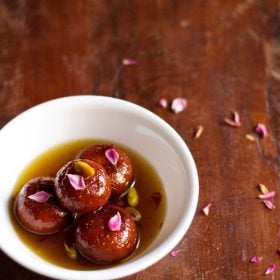
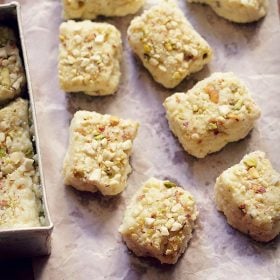
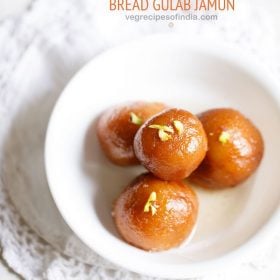
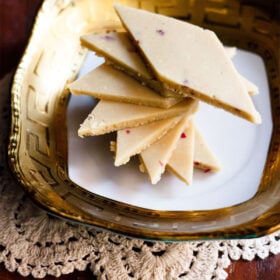
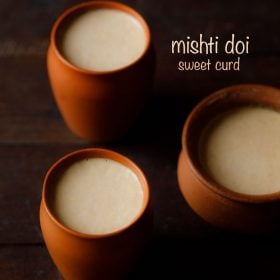
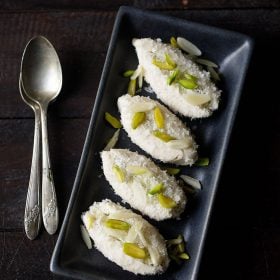
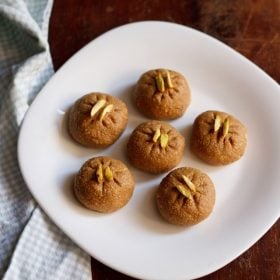
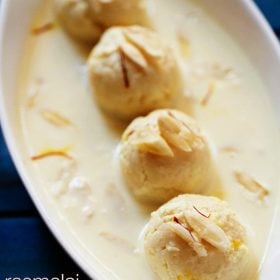








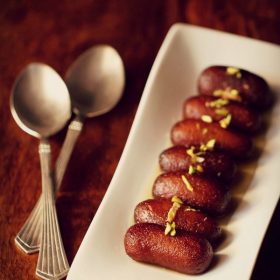
Can I stuff dry fruits inside the jamuns and make in round shape instead of cylindrical shape
yes radhi, you can stuff dry fruits and make a round shape.
Hello,
I made eggless choclate cake following your recipe it turned out superb.here I want to ask that if I use only 250gms of khoya then how much maida and milk should I add.
thanks gurpreet for the feedback on eggless chocolate cake recipe. you mean you don’t want to add paneer? then just add half tablespoon maida and about 2 to 3 teaspoons milk.
hello; I made kala jamun according to your recipe it’s done very tasty but it’s too hard pz reply me
if you mix dough too much, then the jamuns will become hard. also the sugar syrup should not should not have more than 1 string consistency or become too thick. then the jamuns cannot absorb the sugar syrup and will be dense. hope this helps.
Thank u so mch for reply
welcome swapnali 🙂
You are recipe are very easy how to make kala jamun I will try for making this desert
surely try monu and do share your views on kala jamun, thanks for positive views.
Hello mam,
I am a big fan of your recipes I never showed interest in cooking and knew about its importance…. but when I started experimenting your recipes it came so well….just loved to make them really tons of thanks to u….I have a question to u….when I made Kala jamun balls they were hard but when I dropped them in oil it broke into pieces I made home made khova and with equal proportions as you mentioned…. where did I go wrong……blessings from mom greetings from my sis.
thanks a lot pratibha. please do convey my regards to your mom and sis. since you mention that the dough balls were hard, could be that the khova had small tiny balls like granular consistency. the khova/khoya has to have a fine consistency. and this can also be the reason, that after adding them in oil, the jamuns broke.
Hi Dasanna,
Your kala jamun recipe is copied with image and is shining on another blog. Pls check it…There may be many more from your blog.
thanks latha for letting me know. i checked the website and will see what i can do. this person has taken some other recipes as well. its very difficult in cases like these as there is no way you can contact the owner of the website. sometimes the web hosting company also does not respond. i have removed the link and saved it.
Hi mam,
I felt really bad after reading that someone copied your hard work. I would suggest to watermark all your pics with your name/sitename. So that even if someone copies, the original watermark will be there. Just a suggestion
thankyou deepu would surely heed your advice god bless you.
i love the way the recipe is shown with pics.i would suggest u should add the tips also which should be avoided or done compulsorily along with the recipe. or alternatives of the ingredients if possible.Thanks for this lovely n usefull site.
thanks richa. usually i add the tips in the steps and things that can be avoided in most of my recipes.